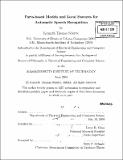| dc.contributor.advisor | James R. Glass. | en_US |
| dc.contributor.author | Schutte, Kenneth Thomas, 1979- | en_US |
| dc.contributor.other | Massachusetts Institute of Technology. Dept. of Electrical Engineering and Computer Science. | en_US |
| dc.date.accessioned | 2010-03-25T15:28:26Z | |
| dc.date.available | 2010-03-25T15:28:26Z | |
| dc.date.copyright | 2009 | en_US |
| dc.date.issued | 2009 | en_US |
| dc.identifier.uri | http://hdl.handle.net/1721.1/53301 | |
| dc.description | Thesis (Ph. D.)--Massachusetts Institute of Technology, Dept. of Electrical Engineering and Computer Science, 2009. | en_US |
| dc.description | Cataloged from PDF version of thesis. | en_US |
| dc.description | Includes bibliographical references (p. 101-108). | en_US |
| dc.description.abstract | While automatic speech recognition (ASR) systems have steadily improved and are now in widespread use, their accuracy continues to lag behind human performance, particularly in adverse conditions. This thesis revisits the basic acoustic modeling assumptions common to most ASR systems and argues that improvements to the underlying model of speech are required to address these shortcomings. A number of problems with the standard method of hidden Markov models (HMMs) and features derived from fixed, frame-based spectra (e.g. MFCCs) are discussed. Based on these problems, a set of desirable properties of an improved acoustic model are proposed, and we present a "parts-based" framework as an alternative. The parts-based model (PBM), based on previous work in machine vision, uses graphical models to represent speech with a deformable template of spectro-temporally localized "parts", as opposed to modeling speech as a sequence of fixed spectral profiles. We discuss the proposed model's relationship to HMMs and segment-based recognizers, and describe how they can be viewed as special cases of the PBM. Two variations of PBMs are described in detail. The first represents each phonetic unit with a set of time-frequency (T-F) "patches" which act as filters over a spectrogram. The model structure encodes the patches' relative T-F positions. The second variation, referred to as a "speech schematic" model, more directly encodes the information in a spectrogram by using simple edge detectors and focusing more on modeling the constraints between parts. | en_US |
| dc.description.abstract | (cont.) We demonstrate the proposed models on various isolated recognition tasks and show the benefits over baseline systems, particularly in noisy conditions and when only limited training data is available. We discuss efficient implementation of the models and describe how they can be combined to build larger recognition systems. It is argued that the flexible templates used in parts-based modeling may provide a better generative model of speech than typical HMMs. | en_US |
| dc.description.statementofresponsibility | by Kenneth Thomas Schutte. | en_US |
| dc.format.extent | 108 p. | en_US |
| dc.language.iso | eng | en_US |
| dc.publisher | Massachusetts Institute of Technology | en_US |
| dc.rights | M.I.T. theses are protected by
copyright. They may be viewed from this source for any purpose, but
reproduction or distribution in any format is prohibited without written
permission. See provided URL for inquiries about permission. | en_US |
| dc.rights.uri | http://dspace.mit.edu/handle/1721.1/7582 | en_US |
| dc.subject | Electrical Engineering and Computer Science. | en_US |
| dc.title | Parts-based models and local features for automatic speech recognition | en_US |
| dc.type | Thesis | en_US |
| dc.description.degree | Ph.D. | en_US |
| dc.contributor.department | Massachusetts Institute of Technology. Department of Electrical Engineering and Computer Science | |
| dc.identifier.oclc | 549279018 | en_US |
